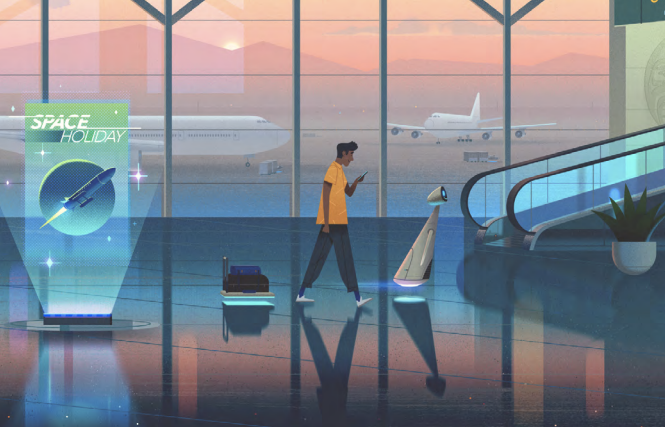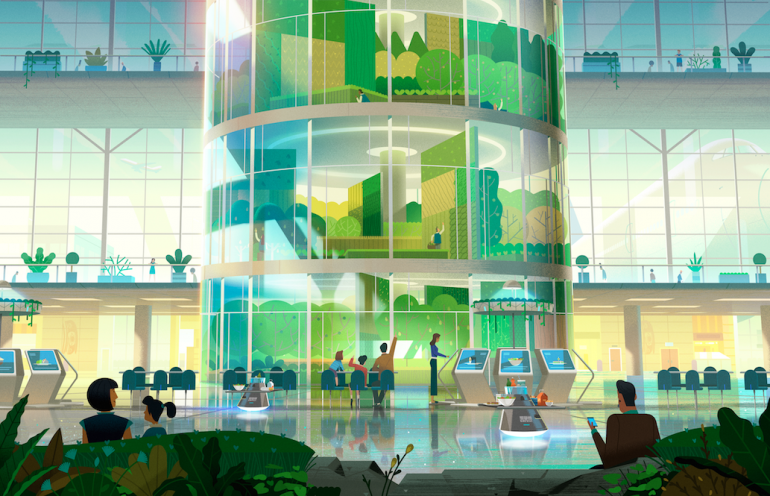Globally, over 8 million people fly every day, and the start and end point of every journey — whether for business or pleasure — is the airport. We have no choice but to pack our bags with essential items along with our feelings and memories and head out to spend time in these hubs for travel. In 2016, many airports are trying to change perceptions about what experiences they can deliver and this is exactly what Vancouver International Airport (YVR) asked me to envision as a Futurist focused on human and societal change with new innovations being introduced.
As part of the YVR 2037 initiative, we designed a future using design fiction storytelling to help us all think about what the future could hold. Here are three three innovations from those stories along with some insight into why they are more than likely going to happen.
Feeding the vegetarian public with vertical farms
-
Once through security, they are greeted by the centrepiece of YVR’s biodiversity and sustainability initiatives – a multi-story tubular structure made of glass. Inside this tower, workers nurture and cultivate fruit, vegetables and plants, adjust atmospheric controls and gather produce for the day.
A holographic YVR Storyteller is on hand to explain – “Welcome to our vertical farm. We use very little water in our hydroponic systems; the water we do use is collected from rainfall and the power we use is harnessed from the sun, via transparent solar panel windows that surround the Departures area. To supplement the vertical farm’s produce, we source fruit and vegetables from the finest growers here in the B.C.’s Lower Mainland.”
The aroma of deliciously cooked food greets them as they arrive in the airport’s Shopping and Dining area. Travellers saunter from store to store, business people congregate on moving walkways, and the international food court offers a scintillating selection of global cuisines.
“My friend Akio told me that the vegetarian cafe here is amazing. Let’s go check it out!” says Deb.
The fact is that we need to find more sustainable ways to grow food as the population grows. Hydroponic and aquaponic farming is on the rise and will become more commonplace in cities. This means more efficient ways of growing fruit and vegetables. And with over 12 million Canadians now choosing plant-based diets, we can see this being a sensible choice for creating an abundance of food for travelers. Vertical farming also means we can produce more in restricted spaces and these are truly amazing sights to see.

Your robot friends
- A YVR Travel Assistant Robot waits at the entrance of the gate. The flight from Delhi landed a few minutes earlier and a successful Indian businessman enters the terminal, stops and checks his headset to see where his transfer will be.
He looks up and spots the Travel Assistant displaying his name and final destination. “Hello, I’m Aarav Sandhu, are you here to take me through to U.S. Departures?”
“Yes sir,” replies the Assistant, “please follow me.”
Aarav follows the Assistant down a hallway. The Assistant stops and turns its screen towards Aarav and a panel slides open revealing a glass scanner.
“Please place your passport on my scanner and look into my screen. We need to scan your details and biometrics before we proceed down the fast track route into U.S. Departures.”
Artificial Intelligence and robotics are making huge leaps and bounds forward in 2016 and it seems that they will become more commonplace. The Robotics Business Review recently outlined the growth in this area, “Universal Robots, which recently reported 91 percent YOY topline growth and predicts that the market for collaborative robots is set to grow 50 percent annually.”
That means that more menial tasks undertaken by humans each day will be taken over by these friendly machines. In the YVR context, I wouldn’t see fewer people, just that these people will be focused on traveller liaison and higher value relationship-based jobs. Ambassadors for YVR Airport, Vancouver, and BC as a whole.
Schiphol Airport in Holland even have has a robot assistant called Spencer rolling around helping people in a trial at the moment.

Believe your eyes
-
This is Pascal’s first visit to Vancouver International Airport. As he wanders inside, his augmented reality glasses alert him to watch the Welcome to YVR Airport story. He accepts, prompting a YVR Storyteller to appear. The Storyteller – one of five hundred, personalized, holographic customer service representatives, helps travellers with wayfinding, gate details and information on airport amenities. The Storyteller accompanies Pascal through the main concourse, detailing the history of YVR and describing the unique journey he is about to experience.
“Vancouver Airport Authority welcomes you to Vancouver International Airport, or YVR. Here we work as an active member of the community to build a sustainable, vibrant, innovative and diverse airport. We also aim to deliver hyper-efficiency with friendly, fast and reliable service for airlines that connect you to friends, family, business partners and associates in Asia, the Americas and beyond.”
Companies like Microsoft, Magic Leap, and META have invested billions of dollars in augmented reality, and are all attracting a huge amount of attention on the idea of a future without screens. Instead, they will allow us to create new environments, experiences, and information interfaces using technology that mixes the real reality our eyes perceive with the generated reality on computer visualization.
No more grabbing your phone, but rather stopping and watching in awe and wonder at cinematic experiences right before our eyes. The possibilities are endless beyond communicating basic information. YVR Airport could be turned into a deep sea environment, scavenger hunt games could be played, and even Bill Reid could talk have a conversation with you about the Jade Canoe and other works of First Nations art.
Visions of the future can be seen over at YVR2037.ca and the public can use these as inspirations to design the near future as part of Phase 2 of the YVR Master Plan, with workshops on the 4th October and an open house on October 12th. To learn more, leave your own feedback or to pre-register to attend a workshop, go to http://www.yvr2037.ca/participate.

